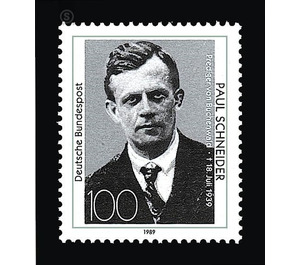50th anniversary of death of Paul Schneider - Germany / Federal Republic of Germany 1989 - 100 Pfennig
Theme: Calender
| Country | Germany / Federal Republic of Germany |
| Issue Date | 1989 |
| Face Value | 100.00 |
| Color | black |
| Perforation | K 13 3/4: 14 |
| Printing Type | 4-color rotogravure |
| Stamp Type | Postage stamp |
| Item Type | Stamp |
| Chronological Issue Number | 1304 |
| Chronological Chapter | GER-BRD |
| SID | 352372 |
| In 54 Wishlists | |
50th anniversary of the death of Pastor Paul Schneider, who, as the »preacher of Buchenwald«, has become one of the most famous martyrs of the Protestant Church during the Nazi era. Paul Schneider was born on August 29, 1897, the son of a pastor in the village of Pferdsfeld (Kreis Kreuznach). He called himself "a simple peasant farmer's son." The love of his homeland and the bondage of nature in which he grew up became for him an unforgettable memory of youth. During the First World War he took an emergency exam and decided to study medicine; but first he volunteered to the front. After a serious injury, he changed his career plans: he wanted to become a pastor. After studying Protestant theology in Giessen, Marburg and Tübingen, Paul Schneider did not immediately go into further church training, but worked of his own free will in a mine near Dortmund to get to know the workers and their problems on site. As a "second man at the blast furnace" he experienced a strong comradeship among his colleagues, but also the social and religious needs of these people and their families. At his first pastoral posts in the Ruhr area and in the Hunsrück, Paul Schneider strove with great earnest faith to encourage the members of the congregation in the politically troubled years between 1926 and 1933 to live a resolute and straightforward Christian way of life. He himself tried to be a role model of courageous and fearless faith. In October 1933 he read in the church a protest against anti-Christian statements of the SA leader Ernst Röhm; then he was sentenced to the small Hunsrück village Dickenschied. Also in Dickenschied it came soon to conflicts between the pastor and the local NSDAP places. Pastor Schneider, for example, defended himself against the fact that representatives of National Socialist organizations were also allowed to speak at church burials, and that the liturgical celebration should not be falsified by ideological statements in their sense. In May 1937 Pastor Schneider was taken into "protective custody" for "political unreliability". The vast majority of the church members campaigned for the arrested and reached his release. But since he did not give up his indomitable attitude to the pseudo-religious doctrines of the National Socialists and continued to publicly protest against them, it came in October 1937 to a new arrest; Paul Schneider was taken to the Buchenwald concentration camp. There he refused to greet the swastika flag at the camp gate, because for him it was not only the emblem of the state, but also the sign of the National Socialist worldview. Because of this refusal, he received a brutal flogging and was locked in the bunker. For fourteen months he had to live here in terrible conditions. Despite all the humiliation and torture, Pastor Schneider at the concentration camp took every opportunity to preach the message of the Gospel to fellow prisoners. Even through the bars of his prison, the "preacher of Buchenwald" kept shouting Bible words in a loud voice until the overseers silenced him. After each such incident, his detention conditions were tightened. As a result of the constant maltreatment, Paul Schneider was a terribly misunderstood, terminally ill man. A dismissal was out of the question, because otherwise the conditions in the concentration camp would have become known in the outside world. On July 18, 1939, Pastor Schneider was killed by a camp doctor by strophanthin injections. With great sympathy of the population Paul Schneider was buried on July 21, 1939 in the cemetery of his former church. Although it was strictly forbidden to make any assumptions or inquiries into the cause of death, it soon became known throughout Germany that a martyr of Jesus Christ, plain as well as upright, had been buried here. (Text: Prof. Dr. Joachim Mehlhausen, Tübingen)


